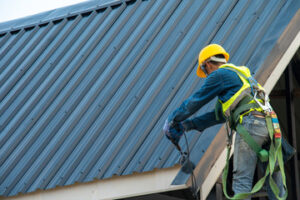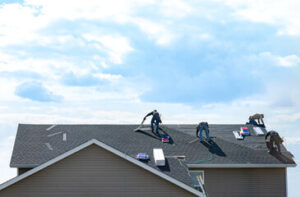Proper maintenance of metal roofs helps them last longer and look better. Keeping them clean and repairing any dents or scratches will help you get the most out of your investment.

Metal Roofing Baton Rouge can be made to mimic nearly any architectural style, so it can blend seamlessly with your home. However, some roofs may require extra care to keep them looking their best.
If you are a homeowner looking for a durable roofing solution, metal is an excellent option. It is much longer lasting than asphalt shingles and can last 50 years or more. It is also fire resistant, which is especially important in areas prone to wildfires. Additionally, metal roofs are less prone to mildew, moss and fungus than shingle roofs.
Steel, aluminum, copper and tin are typically used to create the panels that make up metal roofs. They are formed into sheets that interlock with each other and fastened to the underlying roof frame using hidden or exposed fasteners. They are available in a variety of colors and styles to complement any home style.
Metal roofs have a low weight and are incredibly sturdy, but they can still be damaged. They are prone to dents from hail and foot traffic. However, a quality roof will have several layers of coatings to prevent corrosion.
Unlike shingles, which can become dislodged from the nails that hold them down, metal is strong enough to withstand a significant amount of force. Most manufacturers offer a limited warranty against leaks and other structural damage.
If you are concerned about noise, a metal roof is not significantly louder than an asphalt one. When properly installed over plywood sheathing with the recommended underlayment, a metal roof will not make any noticeable noise during a rainstorm.
A metal roof can be expensive, but it is a long-term investment that will save you money in the long run. Many homeowners are willing to pay the higher upfront cost to get a roof that will last them for decades.
CON: Expansion, contraction and fasteners
Metal expands and contracts at a faster rate than most other roofing materials. This can cause the roof to look wavy or pull fasteners loose over time. Additionally, some metals have a tendency to corrode when they come in contact with water. The neoprene washers that are commonly used to seal the fasteners on metal roofs have a relatively short lifespan. This can lead to the need for replacements.
Energy Efficiency
Metal roofs are more energy efficient than other roofing options. Unlike asphalt shingles that absorb sunlight and trap heat inside the home, metals reflect the radiant heat keeping homes cooler in summer. Combined with effective insulation, this can reduce heating costs in winter and save money on energy bills.
While many people think of corrugated tin roofs when they think of metal roofing, today’s panels are available in a wide range of styles and textures that resemble other types of roofing materials. They are constructed from large pre-formed panels that snap or lock together in a variety of ways. The panels are usually made from steel, aluminum or copper. They can be painted or finished to match other roofing materials and are installed on new construction or replacement roofs.
There are several different panel configurations, thicknesses and coatings to choose from for both residential and commercial projects. For example, there is the standing seam system that uses hidden fasteners and interlocking panels. There is also the shingle style that has a look more like traditional asphalt shingles. Both of these systems can be constructed using corrugated sheets or the more advanced shingles that have concealed fasteners and are produced to resemble wood shakes, slate or tile.
In addition to their longevity and durability, metals are eco-friendly. Unlike traditional shingles that are produced with petroleum, metals can be recycled at the end of their life. This helps to decrease the amount of fossil fuels used to manufacture them and cut down on landfill waste. Additionally, the metal can be melted down and reused to make other products.
Aside from the obvious benefits of durability, longevity and eco-friendliness, a metal roof is a great option for any homeowner that is interested in reducing their energy costs. By lowering their air conditioning usage during hot summer months, homeowners can save up to 40 percent on their monthly energy bills. In addition, the lower energy consumption helps to minimize carbon emissions, which is good for the environment.
Aesthetics
While they were once regarded as an industrial look, today’s metal roofs have become more attractive than their tin-plated predecessors. Today, there are numerous roofing styles and colors available that fit the aesthetics of any home. In fact, a metal roof can be designed to mimic the appearance of clay or concrete tiles, slate, wood shakes, and more. Additionally, a variety of finishes are available that not only protect the metal from corrosion but also contribute to its overall visual appeal.
While most homeowners with a metal roof choose vertical ribbed panels, which use standing seam construction, they aren’t short on options for style. Fans of a more traditional profile can opt for metal shingles manufactured to mimic the appearance of clay or slate tiles, wood shakes, or any other number of designs. And, unlike shingle roofs, a metal roof can be designed to blend seamlessly into any home’s architectural design.
In addition to the aesthetics, many homeowners are drawn to the environmental friendliness of metal roofs. Unlike other roofing materials that can end up clogging landfills, metal can be recycled without degrading its quality or strength.
Another way in which metal roofs are environmentally friendly is that they help promote energy efficiency and can often reduce the need for attic ventilation. This is accomplished through a continuous ridge vent (CRV), which runs across the peak of a metal roof and masks outflow holes on both sides of the ridge. However, with most shingled roofs, attic venting is done through gable vents on both sides of the roof.
Finally, metal roofs are extremely durable. They are able to resist the rust and corrosion caused by moisture, as well as withstand high winds. They are also resistant to fire, making them a safer choice for homes located in areas that have frequent wildfires or wildfire-prone neighborhoods. The durability and longevity of a metal roof can help protect the structure from damage, saving the homeowner money over the long term. These factors make metal roofs an excellent investment for both residential and commercial applications.
Maintenance
A metal roof can last for decades, but dents, scratches, leaks and corrosion will shorten its lifespan if not addressed. Regular maintenance can prevent these problems and also enhance your property’s curb appeal.
Gutter cleaning is one of the most important tasks for maintaining your metal roof. Debris can clog the gutters and cause water to back up into your home or barn. In addition, it can corrode the metal and lead to future damage. Gutters should be cleaned out about twice a year to avoid debris buildup. A professional roofing contractor will have the proper tools and experience to do this safely.
Trimming overhanging branches may not seem like a roof maintenance task, but it is very important to your roof’s health. Overhanging branches can scratch the surface of your roof, compromising its protective coating and causing rust and corrosion. In addition, the branches can snag on your gutters and cause clogs and water damage.
It is also a good idea to check the condition of your metal roof’s flashing. Flashing comprises strips of metal installed along the edges and joints of your roof to divert water away from vulnerable areas of the structure. It also covers areas surrounding penetrations such as chimneys, vents, pipes, skylights and solar panels. Flashing can crack, lift or rust, which exposes the roof to leaks and degradation. During a routine inspection, a professional roofer can check the condition of your flashing to make sure it’s in good shape and properly sealed.
Screws should be checked to ensure they are secure and don’t need replacement. They can be loosened by changes in temperature, which cause the roof to expand and contract. Over time, this can cause the screws to loosen and potentially fall off the roof.
During a maintenance inspection, it is also a good idea to check the integrity of your metal roof’s panels and seams. Leaks can occur if the seams aren’t properly sealed or if they separate or are missing. If a panel is missing, it should be replaced immediately to prevent water damage to the roof and the structure below.
